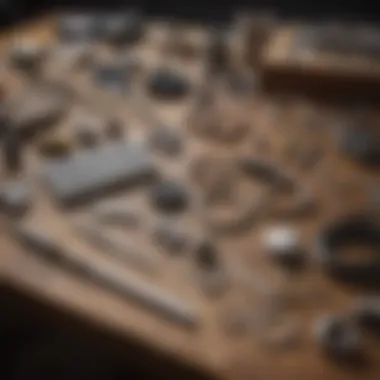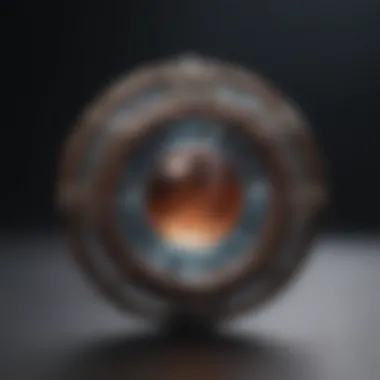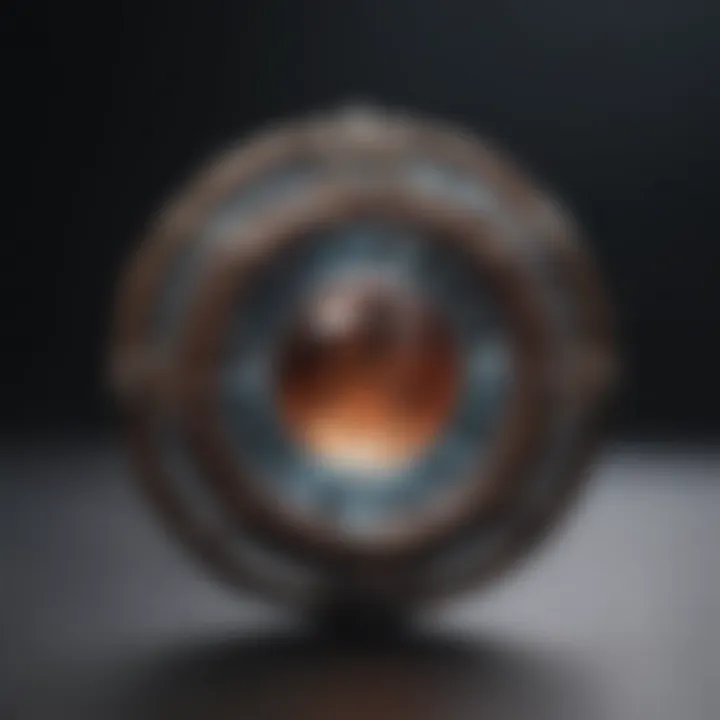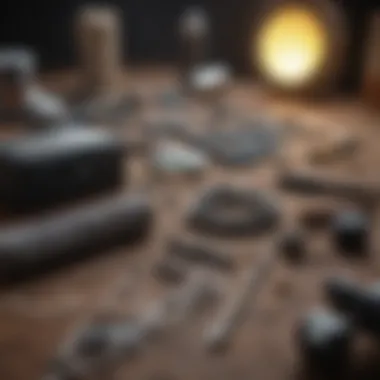Essential Beginners' Guide to Wire Wrapping Kits


Intro
Wire wrapping is an intriguing art form that blends creativity with technical skill. For hobbyists and collectors alike, engaging in wire wrapping opens a pathway to crafting unique designs, whether it's for personal adornment or decorative pieces. A solid wire wrapping kit serves as the backbone for any beginner, offering not just tools but also a glimpse into the world of creativity and craftsmanship.
While the technical side of wire wrapping can seem daunting at first glance, the rewards of creating personalized pieces make it worthwhile. As we delve deeper into this guide, we’ll unravel the essential elements that make up a well-equipped wire wrapping kit, the techniques you need to master, and the tips that can help you avoid common beginner mistakes.
Whether you’re looking to embellish your rock and fossil collection with wire art or to create stunning gifts for friends, understanding the ins and outs of wire wrapping kits will set the foundation for your artistic journey. Let’s get started.
Prolusion to Wire Wrapping
Wire wrapping isn't just a craft; it's a unique form of expression, a bridge between art and tangible creations. With the rise in handmade jewelry and decorative items, understanding wire wrapping becomes crucial for anyone stepping into this vibrant world. The introduction sets the stage for what’s to come in this guide. It emphasizes that getting familiar with wire wrapping opens up endless possibilities, enabling individuals to create custom pieces that tell a story.
While many diving into the craft may feel daunted by the tools and techniques, this embrace of wire wrapping serves as an invitation. It's a chance to transform simple materials into works of art while honing personal skills. Plus, having a grasp on this craft can enhance one’s portfolio, particularly for rock and fossil collectors who often look for creative ways to display their treasures. Whether it’s a delicate pendant or a sturdy ring using wire wrapping techniques, each piece created embodies both artistry and function.
Understanding Wire Wrapping
At its core, wire wrapping is the art of manipulating wire around beads, stones, and other materials to create engaging shapes and intricate designs. Unlike traditional jewelry making methods such as soldering or casting, wire wrapping allows artists to work without specialized equipment, making it accessible to beginners.
The materials can vary widely; everything from copper, silver, and gold-filled wire is fair game. Beginners often start with softer metals, like copper, which are easier to mold and manipulate. Here, skill level often grows hand-in-hand with understanding various wire types, their gauges, and how to best use them for a project's needs. Mastery of basic techniques - coiling, twisting, and binding - not only enhances one’s creations but also builds confidence in the craft.
History and Evolution of Wire Art
Wire art has quite a storied past. Historically, humans have been wrapping materials for adornment since ancient times. The technique dates back thousands of years, with evidence found in artifacts from different cultures. For instance, ancient Egyptians utilized wire to form intricate jewelry pieces, illustrating the craft's deep roots in human expression.
As the years rolled on, the craft moved beyond functional application to become a renowned form of art. It evolved significantly during the Renaissance in Europe, as metalwork took on new intricate designs. The resurgence in handmade crafts during the late 20th century further propelled wire wrapping, reinvigorating interest in artisanal techniques. Today, both traditional and contemporary wire art are displayed in galleries and worn as personal statements, bridging past and present in a brilliant showcase of creativity.
In today’s world, wire wrapping not only serves craft enthusiasts but also appeals to collectors and hobbyists, providing a way to bring their finds to life. The history of wire wrapping thus not only enriches one's understanding but also inspires makers to continue pushing the boundaries of what can be achieved with a simple piece of wire.
What is a Wire Wrapping Kit?
Understanding what a wire wrapping kit encompasses is crucial for any budding artist looking to delve into the world of wire art. Essentially, these kits serve as a gateway, making the intricate craft of wire wrapping more accessible for beginners. Designed to provide all the necessary elements in one package, a wire wrapping kit allows novice creators to experiment without feeling overwhelmed by choice.
The importance of these kits lies in their convenience and educational potential. They typically include everything you might initially need, which can lead to a quicker mastery of the foundational techniques. In addition, well-put-together kits enable users to focus more on weaving their creativity rather than scrambling around sourcing materials.
Components of a Beginner's Wire Wrapping Kit
Wire Types and Gauges
Wire types and gauges play a pivotal role in the success of wire wrapping endeavors. The variety of wires available caters to different artistic needs; for instance, copper wire is popular for its malleability and affordability. It allows a beginner to easily manipulate the wire into various shapes.
When it comes to gauges, thicker wires, like 12 or 14-gauge, are sturdier but harder to bend. Conversely, thinner wires, such as 22 or 24-gauge, are softer and easier for detail work but might not provide adequate support for larger pieces. Therefore, a good balance of wire types and gauges within the kit can greatly facilitate the learning process. It's beneficial for beginners to learn how different wires impact their designs.
Tools and Accessories
Tools are the backbone of effective wire wrapping; they can make or break a project. In a beginner kit, commonly included tools are round-nose and flat-nose pliers, as well as wire cutters. Each type has its purpose—round-nose pliers help create loops, while flat-nose pliers grip and bend wire precisely.
A solid set of tools supports the learning curve. Accessories like bead stoppers or storage cases can keep materials organized and encourage a smoother workflow. Overall, investing in quality tools enhances the wire wrapping experience and can lead to better results in the long run.
Instruction Manuals
A well-illustrated instruction manual is priceless for beginners. Many kits come with guides that break down essential techniques such as coiling and twisting in a clear step-by-step format. This resource demystifies the process, making it easier to grasp complex ideas at first glance.
Moreover, manuals often contain illustrations or photographs that visually guide users through different projects, reinforcing learning through visual cues. This not only boosts confidence but can make even the most intricate projects manageable. With the right instructions, one can avoid common pitfalls associated with wire art, leading to an overall more enjoyable craft experience.
Different Types of Wire Wrapping Kits
Basic Kits
Basic wire wrapping kits are generally tailored for newcomers to the craft. These kits include essential items like basic tools, a selection of wires, and a few project ideas to get things rolling.
The key feature of a basic kit is its simplicity. It offers just enough to introduce the craft without overwhelming a novice. Many find this type of kit to be a cost-effective solution, as the total expense is typically lower than purchasing items separately. However, while basic kits are fantastic for starting out, they may fall short for those who wish to progress quickly or explore a wider range of projects.
Specialized Kits
For those who have honed their skills a bit and are eager to elevate their wire art, specialized kits are where the fun begins. These often focus on particular themes or techniques that can help the artist delve deeper into aspects they enjoy—like creating intricate pendants or unique jewelry styles.
The appeal of specialized kits lies in their targeted approach, allowing users to experiment more effectively in their chosen area. However, these can sometimes become a bit pricey, plus it may limit exploration of other wire wrapping techniques outside the given specialty. A good tip is to assess your interests before diving into one of these kits.
Customizable Kits


Customizable wire wrapping kits are the crème de la crème, offering flexibility that can suit any artist's taste. With customizable options, users can pick and choose which materials they desire, from wire types to tools and even added embellishments like beads or stones.
This personalization allows for a unique crafting experience where each kit reflects individual preferences. However, it can also lead to indecision and potentially higher costs, depending on the selected items. Yet, for serious hobbyists, these kits can provide an unparalleled crafting journey, infusing creativity with endless possibilities.
Selecting the Right Wire Wrapping Kit
Choosing the right wire wrapping kit is crucial for those eager to plunge into the intricate world of wire art. Beginners often find themselves overwhelmed with the variety of kits available, which cater to different skill levels, interests, and styles. A well-suited kit can set the stage for your creative journey, helping you not only to learn effectively but also to enjoy the process of crafting. In this section, we’ll highlight what factors to consider when selecting your kit, ensuring that your entry into wire wrapping is both rewarding and fulfilling.
Assessing Personal Skill Levels
Every wire artist begins their craft with a unique set of skills and experiences, which can greatly affect their choice of kit. It's of utmost importance to evaluate your personal skill level before making a purchase. Newbies may resonate with basic kits that focus on fundamental techniques. These entry-level kits typically include a variety of wires, pliers, and simple instructional guides designed to ease you into the craft without making you feel swamped.
On the other hand, if you've dabbled in crafts before and have a bit of a knack for hands-on projects, then a more advanced kit might be up your alley. Such kits often provide specialized tools and materials that allow for more complex designs and techniques.
"Understanding your starting point can help turn confusion into creativity."
In summary, knowing your current abilities helps in selecting a kit that matches your learning curve, whether you are just starting out or looking to enhance your expertise.
Identifying Personal Interests
An often-overlooked aspect of choosing a wire wrapping kit is identifying personal interests. This goes beyond merely picking a kit; it's about finding a kit that speaks to what you enjoy creating.
For instance, if you have a passion for jewelry making, choose a kit that focuses on creating pendants, earrings, or rings. Conversely, if you are intrigued by home décor or sculpture, look for kits that allow for larger, artistic structures. Identifying what you want to create helps narrow down your options and keeps you motivated.
Moreover, think about styles that appeal to you. Are you drawn to bohemian, minimalist, or vintage designs? Your personal style can guide you toward specific kits designed to produce those aesthetic outcomes.
Choosing a kit that resonates with your interests not only enhances the learning experience but also makes projects feel more fulfilling. By focusing on what you love, you're likely to develop skills faster and enjoy the whole crafting process more.
Essential Tools for Wire Wrapping
Wire wrapping is an art form that merges creativity with craftsmanship, and having the right tools can make all the difference. The essential tools for wire wrapping not only facilitate the crafting process but also dictate the quality of the finished pieces. Beginners need to be equipped with tools that are user-friendly and versatile enough to handle different wire types and projects.
These tools play a crucial role in ensuring that your pieces not only look good but also hold up over time. Therefore, investing in quality tools can save time and reduce frustration down the road.
Pliers: Types and Uses
Pliers are staple tools in any wire wrapping kit, acting as the hands of the crafter. There are several types of pliers, each tailored for specific functions. Here’s a rundown of the main ones:
- Round-Nose Pliers: These pliers are perfect for creating loops and curves. Their tapered design allows for various sizes of rounded ends, making them ideal for both small and larger projects like coiling wire.
- Chain-Nose Pliers: With flat grips on the inside and a pointed tip, chain-nose pliers are your go-to for opening jump rings and gripping small pieces. They excel at holding wire in place while you twist or turn it.
- Flat-Nose Pliers: As their name suggests, flat-nose pliers are used to grip and bend wire flatly. This type is particularly useful in making sharp bends or achieving straight angles in your design.
These pliers are indispensable tools that you’ll reach for frequently. They allow for precision and control, making the process of wire manipulation far easier. Without them, the wire can become unruly, leading to inconsistent or poorly made pieces.
Cutters: Choosing the Right Tool
Once you’ve done your bending and forming, you’ll need a reliable pair of cutters to snip the wire to your desired length. Choosing the right cutters is key to maintaining clean lines and a polished look in each project. Typical choices include:
- Wire Cutters: This tool is specifically designed for cutting through wire. Look for hardened steel cutters, as they can handle various wire gauges and provide a clean cut without fraying the ends.
- Nylon-Jaw Wire Cutters: If you find yourself working with softer materials or artistic wire, nylon-jaw cutters prevent damage to your wire strands. These are also great for preserving the finish on plated or colored wires, ensuring that your work looks its best.
A good cutter can become your best friend in the world of wire wrapping, allowing you to trim pieces with precision while also ensuring your tools last longer. When choosing a cutter, always consider the gauge of wire you frequently use, as not all cutters are built the same.
Other Helpful Accessories
Beyond pliers and cutters, several accessories can enhance your wire wrapping experience:
- Wire Organizer: Keeping your wire organized not only improves efficiency but also creates a cleaner workspace. Look for organizers that accommodate different gauges and colors.
- Ruler or Measuring Tape: Accuracy is a cornerstone of good wire art. Having a ruler or measuring tape handy means you can achieve consistent lengths, which is especially essential when making multiple pieces that are meant to match.
- Bead Alignment Board: For projects that integrate beads or stones, a bead alignment board offers a helpful way to layout your piece before wrapping. This ensures you’re satisfied with design placement before committing.
Tip: Don't underestimate the power of a good workspace. A well-lit area and an organized toolset can work wonders for both creativity and efficiency.
These accessories, while sometimes overlooked, can greatly contribute to the quality of your work and the happiness of your crafting experience. By setting up your workspace with the right tools and accessories, you are laying the groundwork for a successful journey into wire wrapping.
Fundamental Techniques in Wire Wrapping
Understanding the fundamental techniques in wire wrapping is like having the keys to a treasure chest. These basic skills serve as the backbone for every project, guiding you from simple designs to more complex wire art. Mastering these techniques not only allows you to create stunning pieces but also builds your confidence as you advance in this craft. It's about developing a feel for the wire, understanding how it behaves, and using that knowledge to manipulate it efficiently.
Basic Techniques to Master
Coiling
Coiling is a technique that involves wrapping wire around a core component, which can be anything from a bead to another piece of wire. What makes coiling particularly appealing is its simplicity and versatility. It can add beautiful texture to your designs and is a step often used in both simple and intricate projects.
One of the unique features of coiling is the way it can transform a plain wire into something visually appealing. When executed well, coiling can create spiral designs that catch the light and draw the eye. However, it’s important to note that mastering the spacing and tension of your coils takes practice; too loose and the structure falls apart, too tight and it may break.


Binding
The binding technique is essential in wire wrapping. It involves securing one piece of wire to another, often creating a sturdy foundation for your piece. This technique is not only functional but decorative as well, as you can choose how closely you bind the wire, creating various visual effects.
A key characteristic of binding is its role in adding stability to your design. When you bind wires together, especially around a central core, you enhance the durability of your piece. One thing to keep in mind is that the gauge of wire used can greatly influence the overall look. Thicker wire will give a bolder appearance, while thinner wire results in a more delicate finish.
Twisting
Twisting involves spinning two or more wires together, which can give a unique, organic look to your creations. This technique is great for adding dimension and can create intricate patterns when done right. For those making jewelry or decorative art pieces, twisting can be both a decorative element and a way to add strength to your wire structures.
The beauty of twisting lies in its unpredictability. Each twist can be different, which can give each piece a unique flair. However, like other techniques, it does have its challenges; getting equal tension and avoiding kinks in the wire are common hurdles. With practice, though, twisting can elevate your wire wrapping skills significantly.
Tips for Effective Wire Manipulation
Manipulating wire effectively is a skill that improves with practice, but there are a few techniques that can make the learning process smoother.
- Use the Right Tools: Ensure your pliers and cutters are of good quality and comfortable to use. Properly sized tools will reduce hand fatigue and allow for more precise work.
- Practice Makes Perfect: Don’t be afraid to start with scrap wire when experimenting with new techniques. This approach allows you to practice freely without the pressure of ruining a nice piece of wire.
- Take Your Time: Rushing through any technique, especially when you're just starting out, often leads to mistakes. Take it slow to build muscle memory and increase your effectiveness.
Remember, even seasoned wire artists started as beginners. Each twist, turn, and coil is a step toward mastery.
Common Challenges for Beginners
Venturing into wire wrapping is akin to stepping into a new world where many avenues of creativity await exploration. However, as with any art form, there exist challenges that can trip up the unprepared. Identifying these common challenges is not just crucial but serves as a foundational step towards mastering the craft. Addressing frustrations head-on builds resilience and enhances learning, ultimately steering beginners toward a more satisfying experience with wire art. Understanding obstacles fosters patience and allows for growth.
Frustrations with Materials
One of the most significant hurdles for new wire wrappers is grappling with materials. Different types of wire, such as copper, aluminum, and silver, each come with their own quirks and challenges. Beginners often find themselves scratching their heads over gauge sizes, which can be quite confusing. Choosing the wrong gauge might lead to either flimsy projects or overly bulky designs that don't resonate.
Additionally, finding high quality but affordable materials can feel like searching for a needle in a haystack. Here are a few pointers to keep in mind when selecting materials:
- Understand the Wire Types: Each wire has unique properties. For instance, copper is malleable and easy to work with, while silver adds a touch of elegance but can be more demanding on the tools and skills.
- Gauge Matters: The wire gauge affects the project’s durability and appearance. Common gauges for beginners are between 20 to 24.
- Budget for Quality: Investing in good quality materials can save time and frustration in the long run, despite initial costs being higher.
Beginners often feel lost amidst the options, which can lead to disappointment when their projects don’t turn out as planned. This frustration not only stifles creativity but can also lead to discouragement. Recognizing these challenges makes navigating through materials less daunting and more intuitive.
Improving Technique Over Time
Plasticity is a vital trait that one must cultivate in wire wrapping. As beginners immerse themselves, they might stumble over the basics, struggling to make clean loops or secure bindings. These small errors can feel monumental at first, but they are part of the learning curve. To rise above initial setbacks, it's key to focus on incremental improvement.
Here’s how one can approach technique refinement:
- Start Small: Opt for simpler projects that allow for repeated practice of the fundamental techniques. Creating small items might seem trivial, but they build confidence and skill.
- Document Progress: Keep a journal or portfolio of your projects to reflect on what worked and what didn’t. Seeing progress over time can be incredibly motivating.
- Seek Feedback: Engaging with crafting communities, online forums, or social media groups can provide insights and constructive feedback.
"Practice does not make perfect, only perfect practice makes perfect," a saying that rings profoundly true in the art of wire wrapping.
Improving your techniques is not an overnight endeavor; it demands patience and consistent effort. However, as you work through obstacles in your crafting journey, each challenge surmounted leads to a greater connection with the art form and delivers a sense of achievement that deepens your engagement with wire wrapping.
Projects to Try with Your Kit
When you embark on your journey with wire wrapping, diving into projects is a fantastic way to solidify your skills and keep your enthusiasm alive. This section highlights not just the joy of creating, but also the practical benefits of tackling various projects. By engaging in different projects, beginners can experience the satisfaction of transforming raw materials into something beautiful and personal. Each project contributes to building confidence, improving technique, and discovering personal style.
Simple Projects for Beginners
Basic Pendants
Creating basic pendants serves as a wonderful starting point for novices. The simplicity of a pendant allows for experimentation with shapes and designs, fostering creative expression without overwhelming intricacies. What distinguishes basic pendants in this respect is their versatility; you can draw from various inspirations, whether it be nature, geometry, or symbols. These creations also highlight the essential attributes of wire skills, like coiling and wrapping.
A unique feature of basic pendants is that they can be tailored to individual tastes, making them a favored choice among beginners. One can easily adapt the design to feature different gemstones or bead types, enhancing aesthetic appeal without requiring advanced techniques. However, as with all beginner projects, one must keep in mind that initial attempts may result in imperfect pieces, which is normal in the learning process.
Wire Rings
Wire rings bring a touch of elegance while still remaining accessible for those just getting their feet wet in wire art. The engaging nature of crafting a wire ring allows you to build dexterity in your fingers. They can be adjusted to fit different sizes, which is a substantial selling point, making them highly practical. Plus, they’re an immediate jewelry piece that can be worn or gifted, providing instant gratification.
The beauty of wire rings lies in their customization. Incorporating different colors or textures of wire can turn a simple ring into a standout accessory. However, the downside is that precision is required; a poorly shaped ring can frustrate new artisans, leading to unnecessary discouragement. Nonetheless, practicing this project enhances skill level, setting a solid groundwork for future creations.
Progressing to Intermediate Projects
As you gain confidence with basic projects, you naturally find yourself ready to tackle more complex challenges that take your wire wrapping skills to the next level. Intermediate projects introduce more techniques and could lead to stunning creations that captivate both the artisan and their audience.
Earrings


Earrings are a popular choice when stepping into the realm of intermediate projects. Their minimal surface area allows for intricate designs without overwhelming complexity. A major charm of wire-wrapped earrings is how you can fuse different materials to create eye-catching pieces.
Being lightweight, these earrings can feature various styles, from minimalist to ornate. However, they do require a steady hand and a good eye to achieve symmetry and balance. The satisfaction of crafting a unique pair enhances both skill and confidence, demonstrating how wire manipulation can be artful and technical.
Bracelets
Bracelets are an excellent way to showcase an artisan’s evolving style. The beauty of wire bracelets is their adaptability; they can come in various styles ranging from chunky to delicate. Crafting bracelets allows one to weave personal stories into the design, making them excellent gifts or personal adornments. What’s particularly enticing is the opportunity to combine different techniques in one project, showcasing previous skills learned while adding new ones.
The drawback, however, can be the challenge of achieving a secure fit for the wearer. Beginners may find themselves working through adjustments to get it just right, but this journey only enriches the crafting experience. On the whole, focusing on bracelets will push creative boundaries and inspire further artistic exploration.
Engaging in different wire wrapping projects is essential for skill improvement and personal expression. As you progress, you’ll find that each creation not only reflects your growth as an artist but also tells a story of your journey in this captivating art form.
Maintaining Your Wire Wrapping Tools
Keeping your wire wrapping tools in top shape is just as crucial as mastering the art of wrapping itself. The effectiveness and longevity of these tools can make or break your projects. By maintaining your tools, you ensure they perform at their best every time you sit down to create. This not only elevates the quality of your work but also preserves the enjoyment of the craft.
Storage Solutions
Finding the right way to store your tools is essential. A cluttered workspace can lead to frustrating searches for that one specific plier or wire cutter. Here’s a few methods you might find helpful:
- Magnetic strips: Installing a magnetic strip on the wall can help keep your essential tools visible and easily accessible. This way, you won’t end up raiding through a pile of stuff just to find your round-nose pliers.
- Clear containers: Consider using transparent storage containers to hold smaller tools and accessories. Not only does this prevent damage, but it also allows you to easily spot what you need at a glance.
- Tool rolls: For artists who may need to transport their tools, a tool roll can be a game changer. It provides a compact way to keep everything organized and protected while you’re on the go.
These storage solutions help maintain the condition of your tools while keeping your workspace clutter-free. As the saying goes, "A place for everything and everything in its place."
Cleaning and Care Techniques
Cleaning your wire wrapping tools might seem like a no-brainer, but it's often overlooked. Regular maintenance can help avoid wear and tear that might otherwise compromise your tools. Here are some strategies for keeping your tools clean and in good condition:
- Wipe down after use: A quick wipe with a soft cloth after each session can remove residues of wire and dirt. Keeping the tools free from debris reduces the risk of rust, especially if you use tools that may come into contact with moisture.
- Lubricate moving parts: For tools with moving parts, such as cutters or pliers, consider using a drop of machine oil on the hinges. This will smooth out their operation and prolong their lifespan.
- Use gentle cleaners: If your tools become particularly grungy, a mild soap and warm water will do the trick. Just be sure to dry them thoroughly afterward to prevent any rust.
In summary, taking the time to maintain your wire wrapping tools might seem tedious, but it pays off in the long run. You’ll find that when your tools are kept in proper order, your creative process becomes smoother, allowing your artistic vision to shine through.
"Good tools are a craftsman’s best friend. Treat them well!"
By creating good habits in storage and cleaning, your tools can work as hard as you do, keeping you both efficient and delighted in your wire wrapping endeavors.
For more tips and discussions, feel free to explore Reddit, Wikipedia and Facebook for communities that share your passion for wire art.
Community and Resources for Wire Wrapping
Engaging with the community around wire wrapping can be a game-changer for both novice and seasoned crafters alike. Many beginner wire wrappers may feel somewhat isolated in their craft; however, tapping into the wealth of available resources and connections can elevate one’s skills and inspire creativity. Building connections, sharing experiences, and learning from one another fosters an enriching environment that enhances one’s wire wrapping journey.
Online Tutorials and Courses
The digital age has made it easier than ever to access quality wire wrapping education from the comfort of one’s home. Online tutorials and courses provide rich content ranging from beginner tips to advanced techniques. YouTube, for instance, is filled with enthusiastic creators who break down complex processes into digestible segments. Each video can take you through techniques like coiling or creating intricate pendants step-by-step, allowing you to learn at your own pace.
Another great resource is specialized websites dedicated to jewelry making, where many artists post their courses for a small fee or even for free. Platforms like Skillshare and Udemy offer structured courses where you can learn not only the basics but also specialized techniques that can lead to the creation of unique wire art.
Additionally, joining forums or social media groups can supplement these courses by allowing you to ask questions and hear feedback from more experienced artists. Many crafters on sites such as Reddit and Facebook host challenges, share project ideas, and offer constructive critiques, fostering a robust learning community.
"Learning wire wrapping tutorials online can transform your understanding, enabling both creativity and skill growth in a supportive community."
Joining Local Crafting Groups
Being part of a local crafting group can be equally beneficial. These gatherings often provide not just social interaction, but also hands-on learning experiences. Many libraries or community centers host crafting sessions where participants can share tips, tools, and resources. Plus, having a physical space to learn can stimulate creativity in ways that learning online may not.
Finding a local crafting group can be as simple as checking local bulletin boards or social media platforms, such as Facebook. An active group often means a network of friends who inspire one another and can hold you accountable in your crafting goals. These meet-ups can vary from casual gatherings to organized events where projects from all skill levels are encouraged.
Moreover, you might stumble upon events like craft fairs where seasoned artisans showcase their work. This can be an excellent opportunity to learn traditional techniques and discover trends that can enhance your own style.
Getting involved in local crafting groups can lend support during those challenging moments when projects don’t go as planned. The shared experiences and camaraderie within these groups can be a source of motivation, as one finds strength in numbers.
Ending
As we draw this exploration to a close, it becomes evident that wire wrapping is not just a craft; it’s a pathway for creativity and self-expression. This guide has traversed through the essentials of wire wrapping kits specifically aimed at beginners. Understanding the components of these kits, the tools needed, and the foundational techniques is crucial as you embark on your wire art journey.
Reflecting on Your Wire Wrapping Journey
As you reflect on your journey through wire wrapping, consider the growth you have achieved since picking up that first piece of wire. Each twist, each bind, and each project completed wouldn’t just enhance your skills, but they also mark milestones in your artistic evolution. It’s about more than just the final product; it's in the process where real learning happens. You might recall the frustration of tight knots or the excitement of a finished pendant that reflects your unique style.
Moreover, your experiences are rich; perhaps you faced moments when you felt like putting the tools down for good. Yet, those moments of struggle often turn into the biggest lessons. Whether it was mastering a difficult technique or selecting just the right material, these challenges contribute to your growing expertise. The connections you make with fellow enthusiasts—whether experienced craftswomen or newcomers—can offer insights that are invaluable too. Every wire wrapped signifies a little story, a piece of you in its unique form.
Next Steps in Your Craft
With your foundations firm, what comes next? The path ahead can be quite inviting. You might want to delve deeper into specialized techniques or explore different materials that challenge your creativity. For example, consider incorporating stones and beads; they can add a new dimension to your wire art. Look into online tutorials, or perhaps join workshops that focus on advanced wire manipulation. The community around wire wrapping is expansive, and platforms like Reddit or dedicated Facebook groups can provide a treasure trove of information and inspiration.
Furthermore, think about crafting pieces that align with your interests. Are you a rock and fossil collector? Why not create unique jewelry that showcases your collection? Incorporating natural elements could lead your art directly to your heart, combining both hobbies into one enriching experience. The possibilities are limitless; seek inspiration from others, but always remember to inject your unique flavor into your work.



